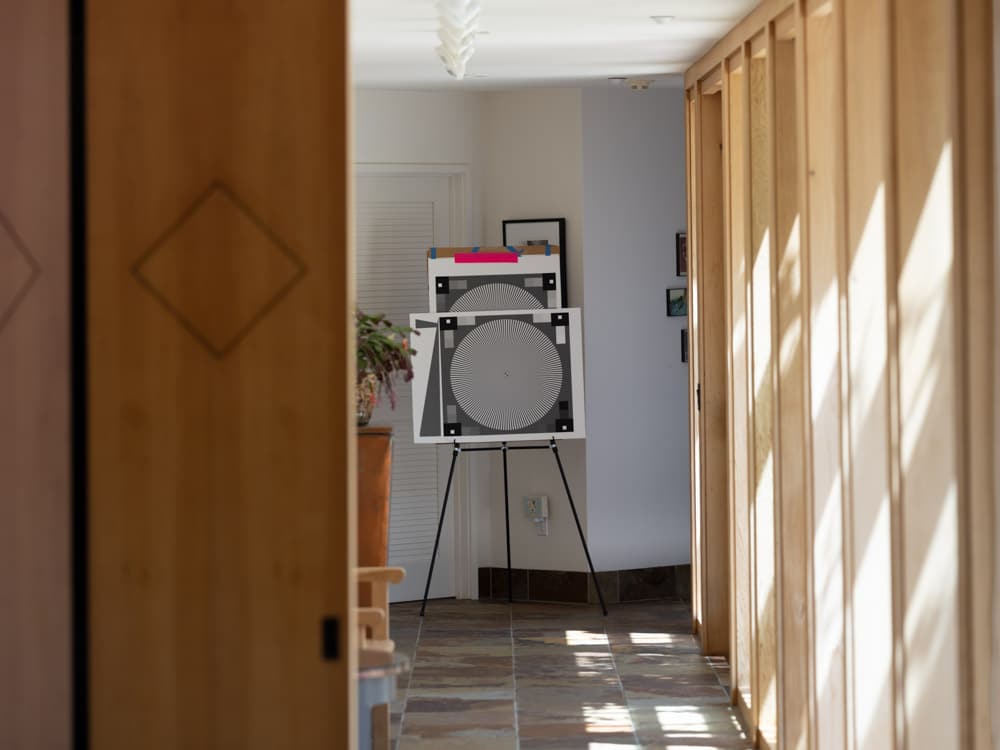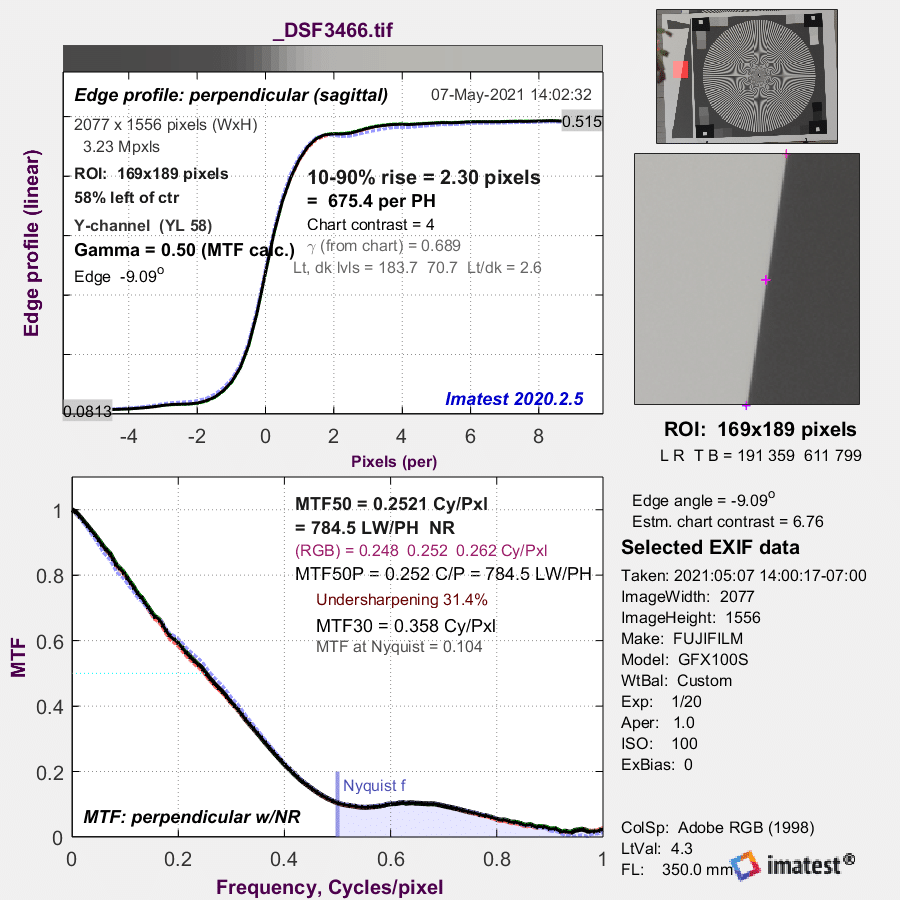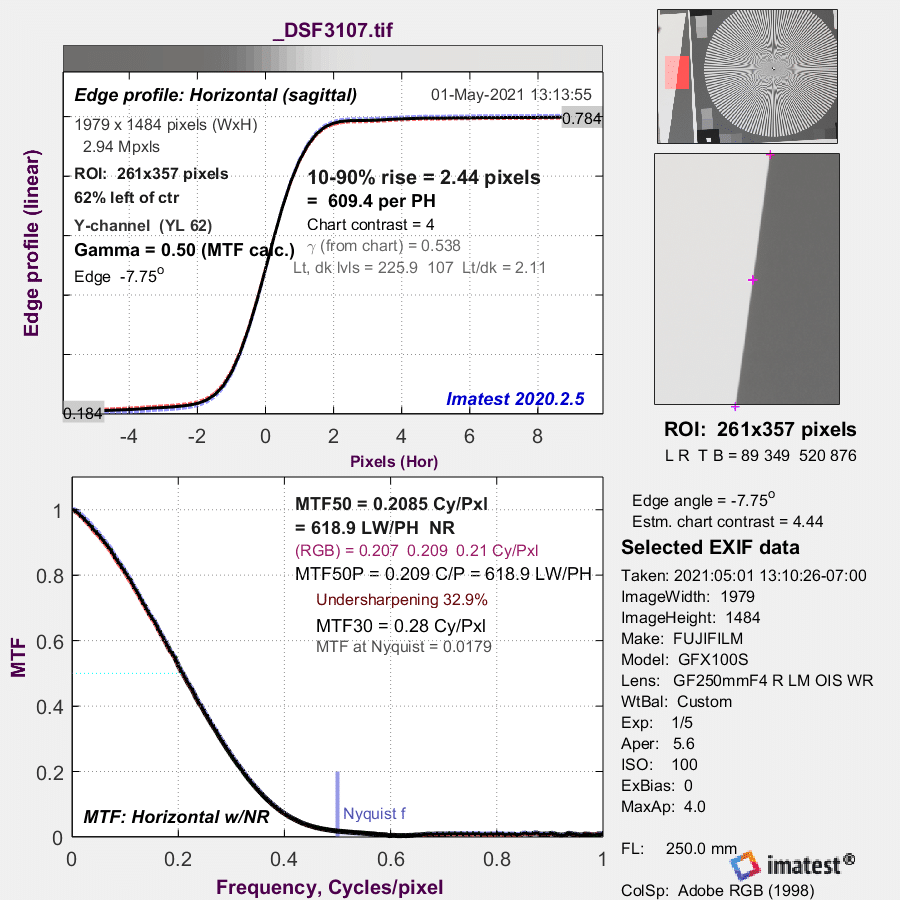This is one in a series of posts on the Fujifilm GFX 100S. You should be able to find all the posts about that camera in the Category List on the right sidebar, below the Articles widget. There’s a drop-down menu there that you can use to get to all the posts in this series; just look for “GFX 100S”.
A few days ago I published this test of the Fujifilm 250 mm f/4 with and without the Fuji 1.4X TC. Readers expressed surprise that the Fuji lens didn’t do better without the TC. Well, I thought, it is a low-contrast target printed on matte paper. Maybe the target itself is the problem. I decided to run another test, this time with the Rodenstock HR Digaron 180 mm f/5.6, attached to the GFX 100S with a Cambo Actus. The previous test was performed at 85 feet. I shortened the distance for this one so that the target appeared the same size at the focal plane.
The scene:
Test conditions:
- RRS carbon fiber legs
- C1 head
- Target distance 85 feet
- ISO 100
- Electronic shutter
- 10-second self timer
- f/5.6
- 1/20 second
- Manual focusing, 6 images
- Picked sharpest one in Imatest
- Develop in Lightroom 10.2
- Sharpening amount 0, radius 1, detail 0
- White balance to gray of chart
- Same minor exposure adjustment
- Rest of settings at default
- Analyse in Imatest
The result:
Here’s the result for the Fuji 250/4 at the same f-stop:
The Rodenstock lens is substantially sharper. And the Fuji 250 had a big advantage here since I could use focus bracketing to nail the focus exactly, while I has to do my best with the too-twitchy Actus focusing rail and the overly sensitive focus peaking in the GFX 100S.



Jim,
Thanks for taking the effort!
It seems that you get around 0.25 cy/px at 50% MTF with that setup. I would be interested of seeing the GF 120/4 tested under the same circumstances.
In my testing I tend to have up to 0.3 cy/px, looking at green channel on ‘unsharpened’ TIFFs from Lightroom. Imatest maybe uses lightness?
I would be interested getting some of your raws, because I am interested in the differences in our testing.
Checked the MTF plots on the HR Digaron-S, a bit better than my Sonnar 180/4 at f/8 on axis, significantly better off axis. Interesting to see that the old Zeiss still does a decent job, so it may seem.
The Rodenstock has much narrower transition 20%–80% on the edge profile indeed. And this more or less matches the gist of the bottom curve plotted by Imatest.
On the other hand, the latter plot IS NOT THE MTF GRAPH! I already explained it a couple of times here, for example, see
https://blog.kasson.com/gfx-100s/fujifilm-gfx-100s-pixel-shift/#comment-263035
Moreover, I took the image 1591-3 from https://blog.kasson.com/the-last-word/pixel-shift-100s-gfx-110/, and manually digitized the center zone of the edge profile. Then I calculated the Fourier transform: it is about 30% at Nyquist, not 7.4%. (This does not EXACTLY match the measured value — about 37% — I gave before; but it is much closer to it!)
BTW, with 5 steps per side of the dotted-square the digitized values are:
[290,288,282,273,253,234,197,149,104,72,39,26,16,13,10]
Here the 0%–100% range is 297–0 (the numbers are distances from the top edge in pixels).
CONCLUSION: it seems that the Imatest’s plots can be compared qualitatively, but are wrong quantitatively. (I suspect that they plot the square of MTF or something like this…)
⁜⁜⁜⁜⁜⁜⁜⁜⁜⁜⁜⁜⁜⁜⁜⁜⁜⁜⁜ Just in case, the calculations:
With 5 steps per side of the dotted-square the digitized values are:
[290,288,282,273,253,234,197,149,104,72,39,26,16,13,10]
Here the 0%–100% range is 297–0 (the numbers are distances from the top edge in pixels). This gives the steps
[2, 6, 9, 20, 19, 37, 48, 45, 32, 33, 13, 10, 3, 3]
Extending the initial curve linearly to 0 in 5 positions on the left and on the right (I’m too lazy to digitize more points honestly…) gives
crvDiffExt=[1.4,1.4,1.4,1.4,1.4,2,6,9,20,19,37,48,45,32,33,13,10,3,3,2,2,2,2,2]
(the approximation I used above would only “smooth” the MTF curve a bit. This is only important near its apex, where it has a sharp corner as in ∧.)
Processing with
MTF(f)=abs(sum(j=1,#crvDiffExt,exp(2*Pi*I*j*f/10)*crvDiffExt[j]/abs(1-exp(2*Pi*I*f/10))*2*Pi*f/10)/297)
plot(x=0.001,2.5,MTF(x))
one can see that MTF goes down to 10% around 1.4×Nyquist.
See this:
https://blog.kasson.com/gfx-100s/rodenstock-180-5-6-digaron-mtfs-compared/
Jim – Have you considered the 5:1 geared Cambo AC-380 Focus Assembly for ACTUS to ease the focus precision issues?
Ordered.